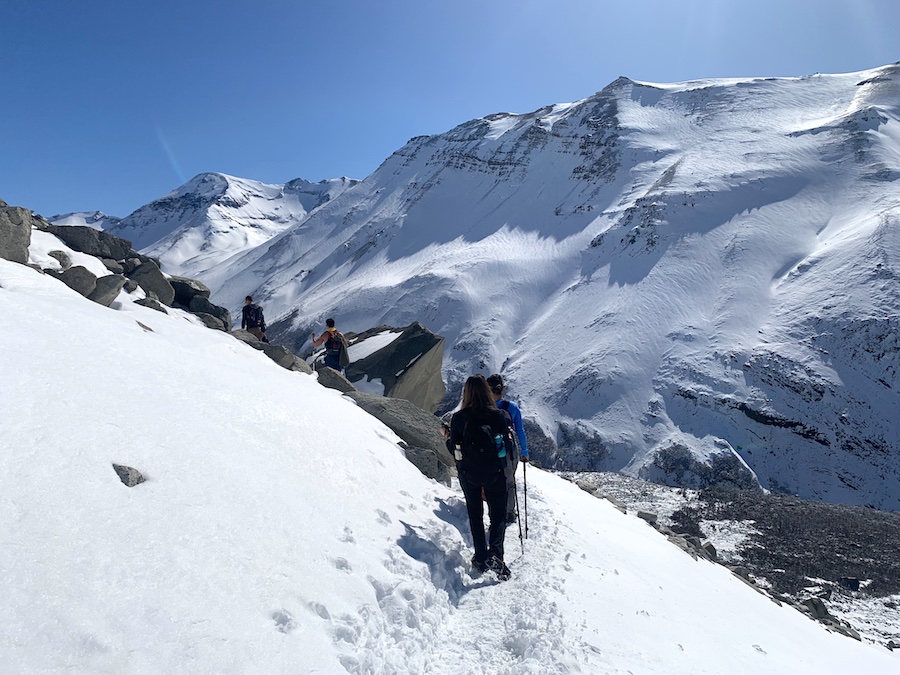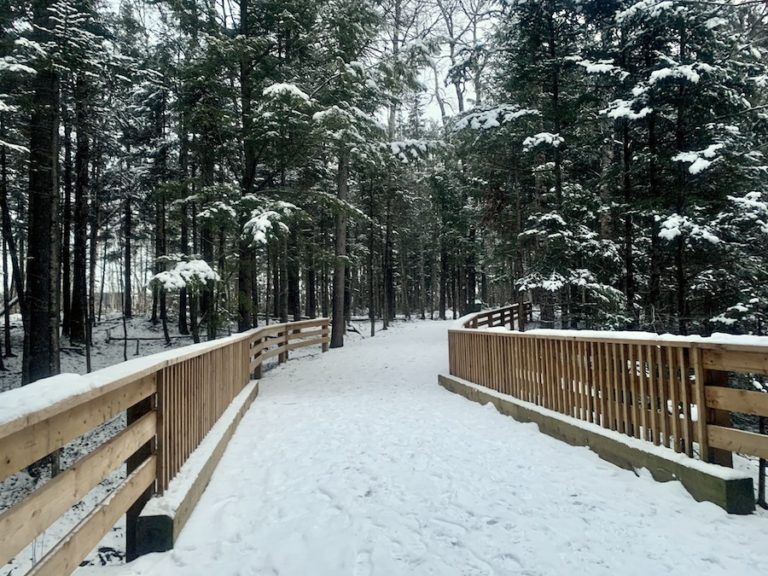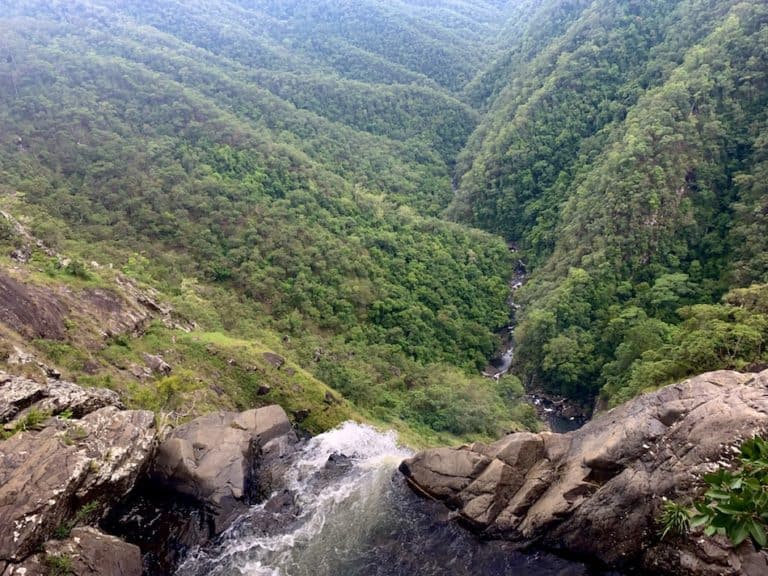Hikers Guide To Winter Hiking
Winter is an excellent season to explore the trails. There are several reasons why winter hiking is amazing. For starters, there are hardly any bugs, very few people around, and there are increased chances of spotting wildlife. Not to mention, the trees look stunning when covered in sparkling snow. However, winter hiking comes with new challenges and terrains to navigate through due to snowy and icy conditions. Knowing what to wear, having proper footwear and traction, staying hydrated, and taking additional safety measures can help you enjoy winter trails safely.
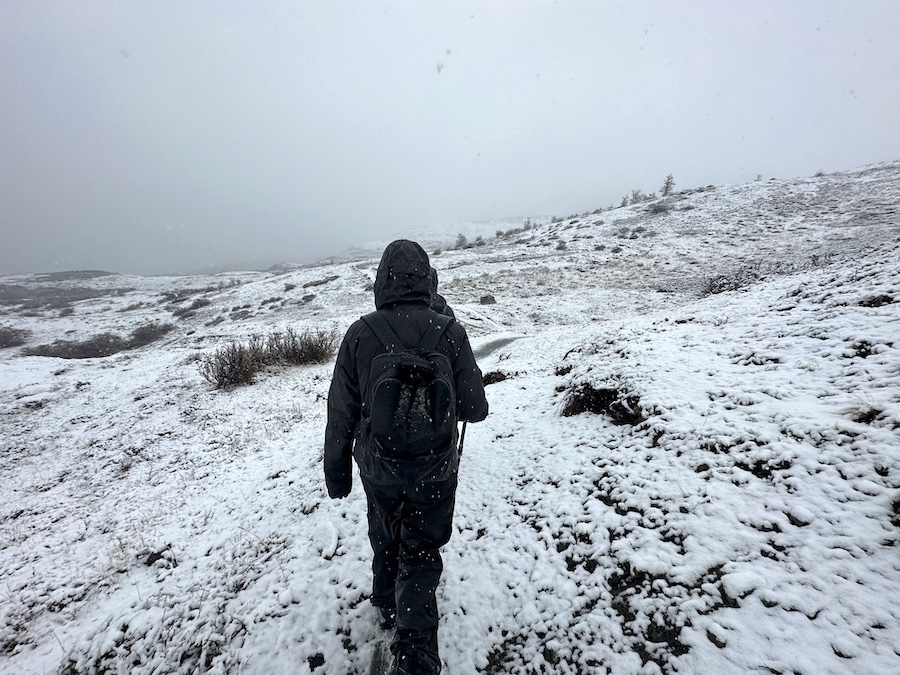
Disclaimer: This article includes affiliate links. If you click one of them, we may receive a small percentage of the sale at no extra cost to you. Thank you for your support!
How To Dress for Winter Hikes
When it comes to comfort and safety, your winter hiking attire is incredibly important. Winter weather can be unpredictable, ranging from biting winds to freezing temperatures and snowfall. To ensure you’re properly dressed for cold-weather adventures, here are a few tips!
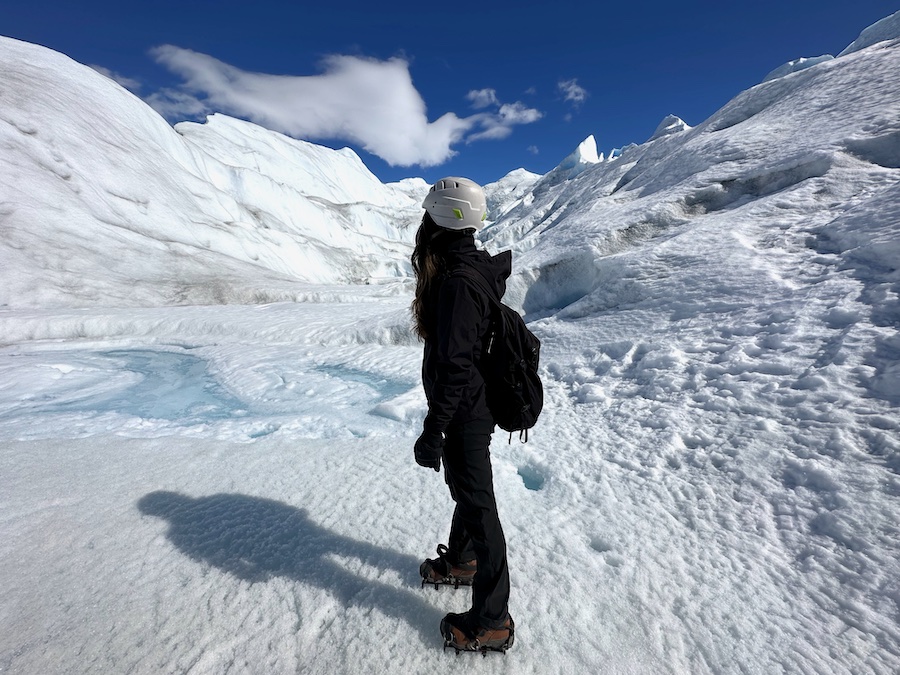
1. Base Layer
The foundation of your winter hiking attire is a moisture-wicking base layer. This layer is necessary for managing sweat, keeping it away from your body to prevent chilling. Opt for materials like merino wool or synthetic fabrics that effectively wick moisture while providing insulation. Avoid cotton, as it retains moisture and can lead to discomfort and an increased risk of hypothermia in cold conditions.
Being the foundation of your winter outdoor attire, wearing a base layer not only helps with warmth but also breathability. A good base layer will allow your body to regulate its temperature.
2. Layering
Insulating layers are designed to trap and retain heat close to your body. Fleece or down-filled jackets are popular choices for winter hikes. The key is to strike a balance between warmth and breathability. Adjust the number and thickness of insulating layers based on the expected temperature and activity level. This allows you to regulate your body temperature by adding or removing layers as needed during the hike.
The base layer manages moisture, the insulating layers retain heat, and the outer layer shields against wind and precipitation. As you begin your hike, you may feel chilly, but as your body warms up, you can remove a layer to prevent overheating. The key is to strike a balance that keeps you warm without causing excessive sweat. Sweating is something you want to try and avoid when hiking in the winter. This is because when you stop, you can get chilled and your sweat may begin to freeze.
3. Waterproof And Windproof Outer Layer
Protecting yourself from the elements requires a reliable outer layer that is both waterproof and windproof. A good quality waterproof jacket with sealed seams and a durable water-repellent (DWR) finish ensures that moisture stays out. Look for features like adjustable hoods, cuffs, and waistbands to seal any potential entry points for cold air or snow. Pair your jacket with waterproof and windproof pants to complete your protective outer layer.
4. Warm Accessories
While winner hiking, your hands, toes and ears are particularly vulnerable to cold temperatures. Invest in thermal socks to keep your feet warm and dry. Ensure your winter hiking boots are insulated and waterproof, providing both warmth and protection. Gloves are essential to protect your hands from frostbite, and a well-insulated hat helps retain heat, as a significant amount of body heat can be lost through the head. Be thorough in covering these extremities to maintain overall warmth and reduce the risk of cold-related injuries.
In addition, a neck gaiter or scarf can provide extra warmth and protection against biting winds. Consider wearing a balaclava or face mask in extremely cold conditions to shield your face. Goggles or sunglasses protect your eyes from snow glare, and hand warmers can be a valuable addition for particularly frigid hikes. These accessories complement your clothing choices, ensuring complete protection against winter elements.
Choosing The Right Footwear

Choosing the right winter hiking boots is important for ensuring you have an enjoyable winter hike. Cold weather introduces additional challenges, such as snow, ice, and freezing temperatures, making your choice of winter hiking boots essential for both comfort and safety.
1. Insulated And Winter Boots
When it comes to winter hiking, insulation and waterproofing are key. Look for boots with effective insulation to keep your feet warm in cold conditions. Insulated boots are designed to trap and retain heat, preventing heat loss in chilly environments. Thinsulate and PrimaLoft are common insulation materials known for their warmth without adding excessive bulk.
Additionally, opt for waterproof boots to shield your feet from snow, slush, and water crossings A waterproof membrane, such as GORE-TEX, ensures that moisture stays out while allowing sweat to escape, keeping your feet dry and comfortable.
2. Traction
Winter trails often come with slippery surfaces, demanding footwear with reliable traction. Choose boots with a robust outsole featuring deep lugs or aggressive treads. Some winter hiking boots come equipped with specialized technologies like IcePick or Arctic Grip, providing enhanced traction on icy surfaces.
For added traction, you can consider investing in crampons or ice cleats to add to the bottom of your boots. These help to add traction and improve mobility on snowy and icy terrains. When we hiked Base Torres in Patagonia in September 2023, wearing crampons was a must after you reached the halfway mark. This, of course, can vary based on the time of year, but when we went, many people turned around before they reached the lookoff as they did not have crampons and it was too risky to high without them.
When in doubt, it’s better to be safe than sorry to keep a pair of crampons or ice cleats in your hiking pack for winter hikes because you never know when you’ll need them.
3. Ankle Support And Stability
Winter terrains can be uneven, and the risk of slipping or twisting an ankle is higher. Choose winter hiking boots that offer adequate ankle support to reduce the risk of injuries. Boots with a higher cut provide stability and help prevent ankle rolls. Look for features like padded ankle collars and reinforced heel counters to enhance support. Proper ankle support is especially crucial when navigating through snowy or icy trails, ensuring your boots provide the necessary stability on challenging surfaces.
4. Use Gaiters
If you want to add extra protection against snow and prevent it from entering your roots, consider using gaiters. Gaiters are worn over the top of your boots and lower legs, creating a barrier that prevents snow, debris, and moisture from getting inside. This accessory is particularly beneficial when hiking in deep snow or traversing through areas with snowdrifts.
5. Break In Your Boots
Before embarking on a winter hike, take the time to break in your boots. New boots, even those designed for winter conditions, may need some time to mould to your feet and soften in critical areas. Wear them around the house or during shorter walks to allow the materials to adapt to your foot shape. This practice reduces the risk of discomfort, blisters, or other issues during a more extended winter hike
For more information on how to prevent blisters, check out our article”How To Prevent Blisters When Hiking“.
Staying Hydrated On Winter Hikes
Hydration is a factor you should consider for several reasons during winter hiking. Firstly, it helps regulate your body temperature, allowing your body to efficiently generate heat. Staying hydrated also supports cardiovascular function, ensuring that your heart can efficiently pump blood and oxygen to your muscles. This is especially important during cold weather, where the body works harder to maintain warmth.
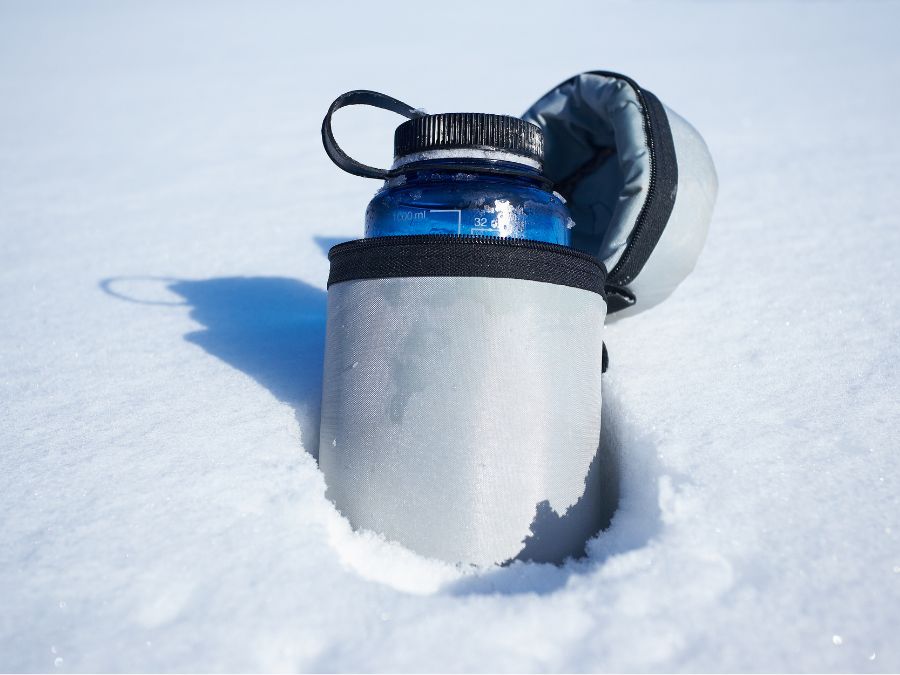
1. Use Insulated Water Bottles
In cold weather, water in your bottle can freeze, making it challenging to stay hydrated. Invest in insulated water bottles to prevent freezing. Consider adding an insulating sleeve or cover for extra protection against the cold.
2. Bring Warm Beverages
Drinking cold water in frigid temperatures may not be appealing. Consider opting for warm beverages like herbal tea, hot water with lemon, or diluted sports drinks. Warm drinks not only contribute to hydration but also provide a comforting element during colder hikes.
3. Hydrate Regularly
Even if you don’t feel as thirsty as you would in warmer weather, make a conscious effort to hydrate regularly. Set a schedule for drinking water or warm beverages during breaks to ensure a consistent intake throughout your winter hike.
4. Eat High-Water Content Snacks
When hiking, try bringing snacks with high water content. Fruits like oranges, watermelon, and berries, as well as vegetables like cucumber and celery, contribute to your overall hydration. These foods also provide essential nutrients and energy for your hike.
Safety Precautions for Winter Trails
Winter hiking introduces unique challenges and potential hazards that require careful consideration to ensure a safe and enjoyable hike. Knowing how to navigate the trails and prepare for the cold weather can be incredibly helpful.
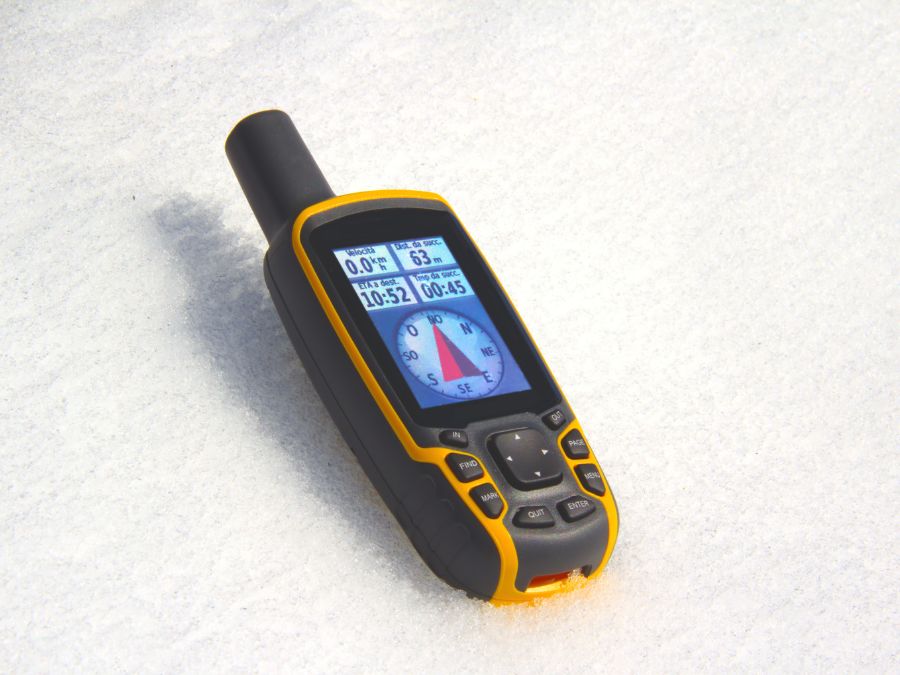
Here are a few tips to keep yourself prepared and safe when hiking during the winter.
1. Tell Someone About Your Plans
One of the fundamental safety measures for any hiking adventure, especially in winter or when hiking alone, is informing someone about your plans. Before setting out, share details with a friend, family member, or a reliable contact. Let them know your planned route, expected duration, and the time you plan to return. In the event of an emergency, this information is crucial for search and rescue efforts. A simple precaution like informing someone can greatly enhance your safety during winter hikes.
2. Bring Emergency Gear
Winter conditions can be unpredictable, and being prepared with essential safety gear is non-negotiable. Prioritize items such as:
A Map and Compass
Nowadays, technology is a great asset, especially to hikers. However, you can run into issues when on the trails such as poor to no signal, batteries dying and unexpected damage. For this reason, we suggest bringing a map and compass when doing new, overnight and winter hikers. Winter conditions may obscure trail markers, making it important to have a reliable means of determining your location and trail direction.
GPS Device
While a map and compass are indispensable, a GPS device adds an extra layer of precision to your navigation toolkit. Ensure it is fully charged, and you have spare batteries or a portable charger. This could be your cellphone GPS or handheld GPS such as the Garmin eTrex 22x.
First Aid Kit
A well-equipped first aid kit is a great asset to your winter hiking pack for addressing minor injuries and unexpected situations. Include items like bandages, antiseptic wipes, pain relievers, and any necessary personal medications. You could also include a compact, lightweight emergency shelter or blanket, such as a bivvy or emergency blanket, which can be a life savour in case of unexpected delays, extreme weather, or emergencies.
A Multi-Tool
A versatile multi-tool can be invaluable for addressing various situations, from gear repairs to basic survival needs.
Headlamp or Flashlight
Winter days are shorter, and darkness can descend quickly. Carry a reliable headlamp or flashlight with extra batteries to ensure visibility during low-light conditions.
3. Keep An Eye On the Weather
Winter weather can be unpredictable, with the conditions changing rapidly. Before setting out on your hike, be sure to check the weather forecast. Monitor updates closer to your departure time so you have time to adjust for any last-minute changes. Sudden snowstorms, freezing rain, or high winds can significantly impact your safety on the trail, so staying weather-aware is a key precautionary measure.
4. Prepare For Early Darkness
Winter days come with shorter daylight hours, and it’s important to plan your hike with early darkness in mind. Start your hike early to maximize daylight and allow enough time to complete your hike. Carry a reliable headlamp or flashlight, even if you anticipate completing your hike before dark. Unforeseen delays, weather changes, or challenging terrain can alter your pace, making early darkness a potential factor to consider for your safety during winter explorations.
5. Be Sure To Wear Sunscreen
Wearing sunscreen during winter hikes might not be the first thing that comes to mind when gearing up for a snowy adventure, but it’s just as important as during the summer months, if not more so. Snow acts as a powerful reflector, bouncing UV rays from the sun back onto your skin. This can lead to unexpected and severe sunburns, especially in high-altitude areas where UV exposure is intensified. Remember to apply sunscreen every two hours, especially after sweating or coming into contact with snow, as it helps maintain its effectiveness throughout your winter hike.

